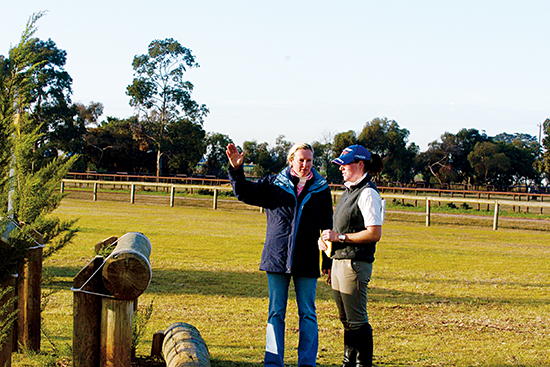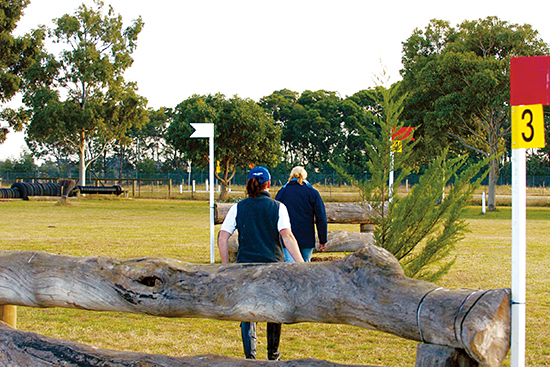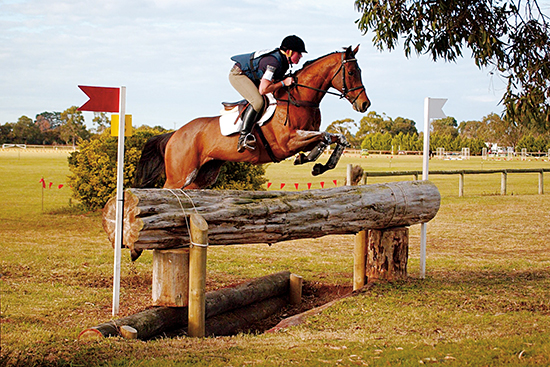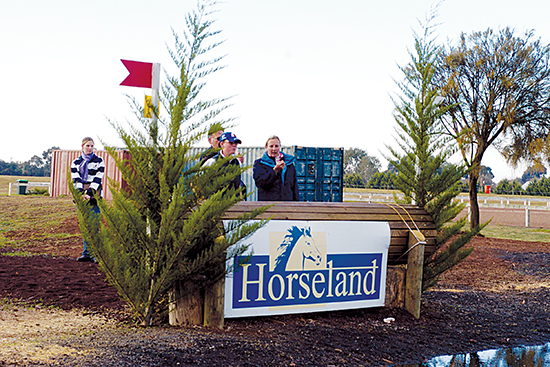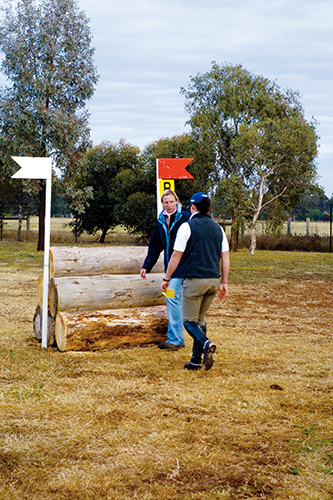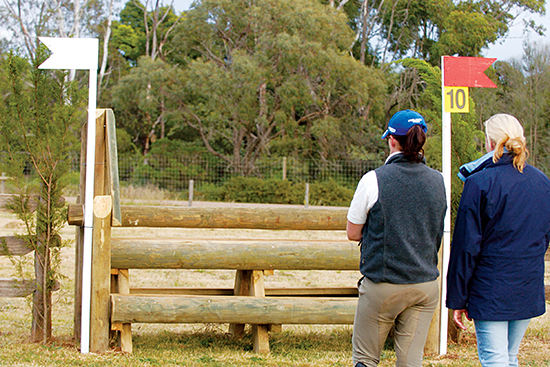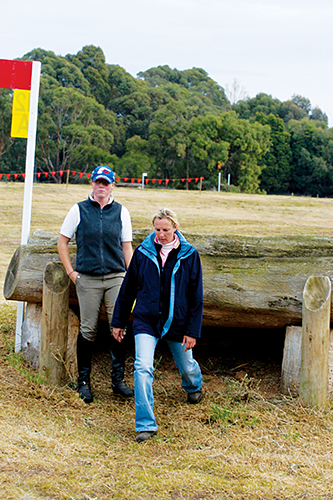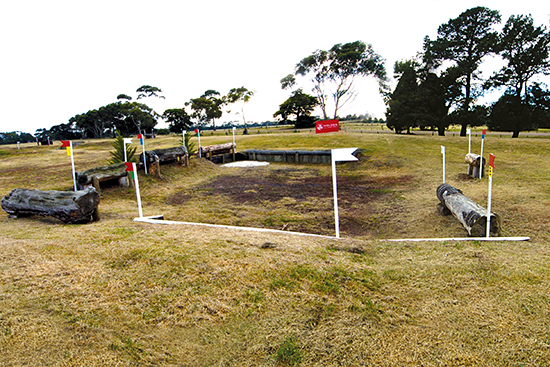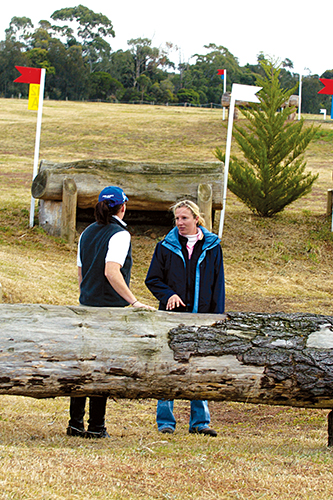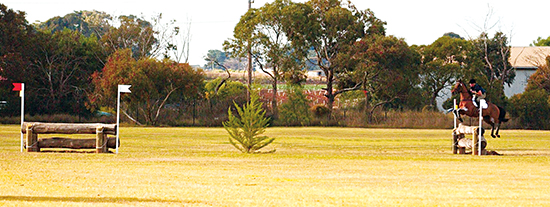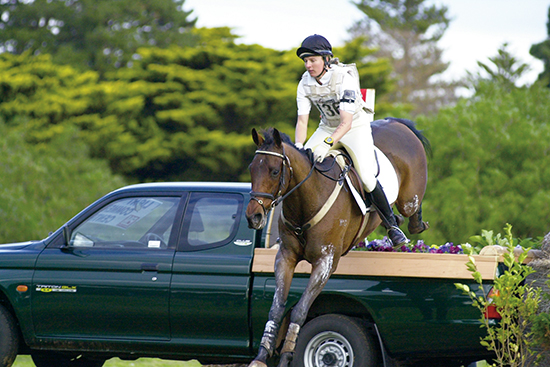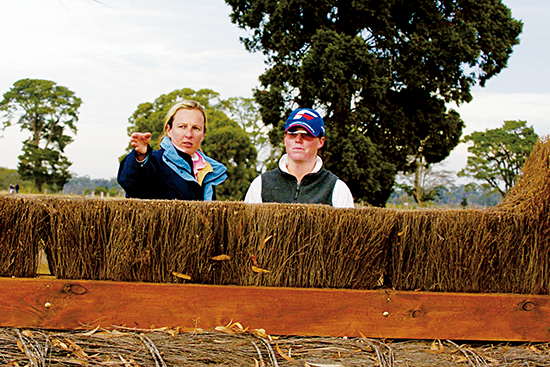 Story by Chris Hector & Photos by Roz Neave, Julie Wilson and Derek O’Leary
Story by Chris Hector & Photos by Roz Neave, Julie Wilson and Derek O’Leary
Missed part one? GO TO http://www.horsemagazine.com/thm/2015/03/tally-goes-to-melbourne-3de-part-one/
Have you ever wondered what it would be like to walk the course with a trainer to analyse every single jump for you? Well sit back and enjoy as Christine Bates takes young Tally Barwick on a walk of the one star track at Melbourne Three Day event. It is an amazing experience to see the course through such expert eyes….
THE COURSE WALK
Before we even leave the start box, Christine is drilling Tally on her preparation for the big event – her first one star Three Day Event.
“I want you to start to warm up half an hour before your start. Walk, trot, canter, a bit of a sprint, jump quite a few fences. Then let her have a break and a bit of a walk, then just pick it up again, and come out of the start box.
The idea is to try and simulate how the steeplechase used to affect the cross country, give her a pipe opener so she is warmed up and on the job, and then let her cool down, what was the ten minute box effect. Then wind her up two or three minutes before start time.”
And don’t take any fence lightly – even the first: “Jump out of the start box, and go, and then sit up and be organized for the first fence. Don’t come out of the start box backward, no cantering to a vertical. It is very important with your first couple of fences that you get confident, strong jumps so that you can get on your minute markers and on the time and she is going to be jumping confidently.”
FENCE ONE: The Mansion Hotel Rockery – Softened upright dressage with mulch and rocks, height 1.08
“If you come out of the start box backward, you are not organized and don’t get such good rides over your first couple that makes it hard. After this first fence, open her up a bit, but I don’t want you to feel you are running her off her feet, if you come out of the start box and you fang over the first two fences, that can shake them up a bit. You are still going to be on your first minute marker, but you shouldn’t stress her by being wild.”
FENCE TWO: Oxer, height 1.07, spread 1.27
“It’s a nice curving line onto the second fence, use the turn to set her up. With her it should just be a matter of sitting up through your turn, and jumping this oxer out of your rhythm. I want you to land and be pointing in the direction of your next fence, don’t cut the corner and be heading out to the right, when you need to be going back to the left a little. Almost give her the feeling you are jumping a little right to left, don’t get the feeling that she bulges on the turn and lands out there to the right, you want to land thinking, let’s go.”
THIRD FENCE: Softened upright, 1.10
“Okay, go for a bit of a gallop, sit up, check the organization and how much she’s on the job, so that you know when you get to this next fence that the turn is not going to be an issue, you are not going to get a resistance.”
FENCE FOUR: The Polo Turn softened upright, 1.05
“Just jump the fence to the right of that knot in the wood and then four strides to the middle of number four. It’s early on the course, don’t forget you are sitting on quite an experienced horse, the angles aren’t too tough, and they are not too big. Use a curve to set her up, get her eye on it early, you’ve got four good strides to show her the line, pop in there, one, two, three, four, pop out. I think jumping the first one straight and going round the tree is unnecessary. It’s very jumpable provided you set it up well, get her eye on it early, hold your line and the four comes nicely. Make sure you have ridden the approach very well. The mistake you can make is galloping across the polo field, leaving the set up for the fence late, and then swinging off her head at the first. You don’t want that, you want to be able to come through that turn and ride, and go come on, let’s go.”
“A lot of people lose time on landing. The moment you land, gallop. She’s been trained by me to do that – that gives you a few more seconds in front of the fence to be able to organize her and set her up.”
HEADING TO FIVE: Trakehner 1.10, base spread 1.66
Once again, Christine Bates is drilling her student: “I’d keep galloping to this brush and I’d just sit up and try to catch this out of my rhythm. I don’t want to make anything more of this, than, ‘there is it, it’s a log with a nice ditch under it, jump it’ and jump it slightly left of centre. There’s a good ground line. It’s not big, it’s there to be jumped, jump it. You are going to turn, I’d say inside of those trees – if you go around those trees you are just taking extra time which on her you don’t need to do.”
“If you were more experienced, I would tell you to jump it more on the angle, but this is your first one star and we are going to play it safe. Maybe we’ll have a change of plans. Land, go round that tree and keep motoring. If we jump it where we want to jump it, that makes the inside turn a little tight, land and keep going and that will be quicker than you trying to jump this where we want to jump it and trying to get that inside turn. If she jumps it great, and she is not being gobby and yeah, you think the inside turn is on, great. If not, I know if you jump that log and keep travelling you’ll be fine for time.”
GOING TO SIX: Big log, 1.7
“Pop the log, showjump, just pop the log, and land so you can get your turn, you are going to have to go round those pine trees, so make sure you’ve got her back, pop there. So you can start riding that bend the moment you get straight heading in the direction you want to go.”
“Remember she doesn’t turn as well to the right as she does to the left, so you are going to set that up more than what you would want to do for a normal log, then the moment you have made your turn, she needs to be back in your hand, thinking, right we’ve got a water jump here, let’s get back on the job.”
HORSELAND WATER: 7A – Narrow Palisade, height 1.05, jumpable width 1.5; 7B – Drop, 1.34 m, Roll Top; 7C – Narrow Palisade, 1.04, jumpable width 1.5
“You want at least three or four strides dead straight at A, so she knows where she is going, you get your eye on it earlier to get your distance right to the little arrowhead.”
APPROACH TO SEVEN
“She hasn’t jumped a lot of combinations to water, she is always very good to water, but I want you to ride this well, get her eye on it early, set it up well, so she gets a good strong confident jump through here. Don’t think ‘I am sitting on an intermediate horse, I can just canter around and get this’. When you want to wait, she drops behind your leg and gets a bit weak. I don’t want that, I’d rather you be more forward than the opposite. She’s very quick, very athletic, I want you to get to the base, I don’t want you to catch the fence flat, a nice round jump so you can really ride: one, two, and again a strong jump into water. If you jump in flat, and she takes two flat strides and you are like ‘oh shit this is going to be deep’ and have to go whoa on her, then she is going to be weak into the water.”
“Be very connected in front of the arrowhead and ride, one, two, keep her strong. The moment you are in the air, your eye is on C, the moment you land, sit up, turn and ride out to C. I don’t want to see you land in here and get in front of her, go three strides and say oh heck, I’ve got an arrowhead. It has to be very on the job, very organized the moment you are in the air over this fence. If you get backward coming into the water you automatically take her eye off the fence…”
“She will land in the water and she will probably take a stride before you turn. I want you to have in your head ‘keep my position, I’ve got my eye on it, there it is, ride forward’. It is tough enough and it is early in the course. You haven’t really had a test of accuracy and boldness yet, you have your angle logs at three and four but they are a relatively soft angle. The key to this fence, is that having ridden your first six really well, and because you have slowed down to jump that log at 6, get your turn, come forward, then set up, then you are right. Don’t get the turn and be quiet all the way over here to the water – one because you are wasting time, and two because you need to have her in your hand, you need to have a good strong canter into the arrowhead out at C.”
FENCE 8A: Height 0.80, drop 1.50 m, logs with drop off bank
“After that water let her travel. Let this fence going up the rise of the bank slow her up, you shouldn’t have to be thinking, oh come here, just keep her head up, get your line early, keep a nice connected canter, the moment you jump the first part, your eyes have to stay on B.”
FENCE 8B: Height 1.10, jumpable width 1.30 – Narrow logs
“Don’t get in front of her off the drop, keep your position, hold your line. Even if she does something silly, catches a stifle, you’ve got to keep your position; you’ve got to keep your line. Be careful that she isn’t thinking, what’s coming up next, is this another water jump? She’s got to be confident, strong, yep we are jumping off another drop to an arrowhead.”
“You are relatively inexperienced, and to me this fence has been put here because people have jumped through the water, could have had a bit of a save, and all of a sudden they’ve got another drop to another arrow head. That is why this fence has been put here.”
“I think you’ll find she probably won’t jump off huge, off that drop and you will find that you’ll land, have to move up and kick her up a little in front. Don’t forget she is that bit downhill, and she’ll land in a heap, and you’ll have to go, hey, sit up! And get her eye on it. She might pop off the bank fantastic, line up the arrowhead and keep travelling sweetly in three; but the thing they can do here, is drop off weak in a heap and your reaction isn’t quick enough to get her happening to that arrowhead.”
“It walks three to the base. It all depends on how they land off that drop, and if you catch that drop quite big and open, the three is going to be very tight. I want you to get quite close to the bank to the drop, so that she pops down – we don’t want a huge flat ‘jump-out-land-in-a-mess’ happening.”
And the message is, it’s not just the jumps you have to watch…
“All these gateways at Melbourne have always caught riders out because they can be slippery, I’ve seen quite a few people have fantastic clear rounds then have a silly fall on a corner through a gate.”
“I always find in the first minute that I have to push myself to stay up on the time, they are cold, especially now with the change of long to short format and they are slower to kick into gear. Then I think your second minute is going to be slow. You’ve got the Trakehner, turn to the log, water complex, then another bank complex – you will probably find going across here you are on a catch up mission to get back on your marker. I wouldn’t panic, if your second minute marker goes off, and you are down, she gallops well, she’s fit, catch it back up here.”
COMING TO 9 Horseland Mansion Drive: Brush with softened front, height 1.24
“Just before the gateway, I would probably be coming back a notch, I would have put my foot down but coming into this, it’s not a combination but they are related. I wouldn’t want to have gone for a big gallop then realised, oh hell she hasn’t come back! I’d do a nice re-balance here, I’d wash off some pace, ride it like it’s just a brush, don’t make it more complicated than what it has to be. Don’t over set up – you have got a right turn now, remember she doesn’t turn as well that way. I’d jump just a smidgeon left of right…”
Coming UP TO THE SERIES OF FENCES INTO THE CAMEL PADDOCK FENCE 10: Oxer, height 1.10 spread 0.30, base spread 1.35
“In the years that I have been here competing, there’s always been problems at these fences for all the grades, I think this timber blends into the ground, it’s not very obvious what the top rail is, so don’t take this for granted. You keep her connected, keep her eye on this fence, keep the canter strong. It is only going to cause you problems if you’ve got there weak and deep and on the forehand, you’ve got plenty of time, sit up through your turn, stay nice and connected, it doesn’t matter if you have to move up, that’s alright, if you are connected and strong it will be fine.”
“Here it all blends, there is nothing specific to say, this is your fence – if it had flowers under it or something to draw them to it, I think when it is a bit timber timber timber, either side of the fence, they don’t switch on to it.
Watch it though, after the vertical work out where you are going – line up your next fence.”
FENCE 11: Drop 1.40, ascending logs
“Funnily enough this fence has caused problems in the past. It is another drop landing, so that can make horses a little suspicious if they are not getting a good confident ride off the drops. You are probably going to use this boring old bush as your marker – that’s where you need to get on the fence line. Travelling down here, strongly but not fast, you’ve got to make sure when you turn up here that you go forward, up to it. You’ve got to ride it with the feeling of a pimple fence, that you are riding it stronger than you would like to, but from a very organized, balanced canter off your turn. Your turn helps you see distance, and when you have spotted your distance, ride to it, don’t get caught getting backward and weak. And don’t lose your position.”
“I think for a one star horse, you want to jump this fairly straight. If you were sitting on a two star horse, I would want to put an angle on it, but I think in your situation, I would like to see you jump it straighter. From that bushy tree to your turn is where you’ve got her in your hand, so the moment you make your turn you can say, go. Make sure over the fence, that you stay straight, don’t let her come up the hill and jump out to the left.”
APPROACHING 12A Holden All Wheel Drive Water: Drop 1.50 Ascending logs
“You’ll automatically land after that drop and she’ll keep travelling. Because she comes back to you pretty good, keep travelling until you are straight, balance her, very organized, stay forward. It doesn’t matter if you get deep to the log, or if you have a chip – not that I want that to happen, but you’ve got to stay strong so that they jump strongly in. I don’t want you to jump, hoot around her, ‘oh dear I haven’t seen a distance’ and be swinging off her head and being backward.”
ANOTHER DROP
“By now she could be getting better with drops, or it could go the other way and start to say ‘hey I’m starting to get a bit sick of jumping off drops’.”
LOOKING AT THE WATER JUMP WITH NO WATER IN IT:
“It is actually quite good to see this without the water. See how it is a bit undulating in there, it is a little inconsistent – make sure the moment you land, you keep hold of her head. I’ve jumped in the opposite way and gone to turn and hit a hole, and ended up under the water. It wasn’t even fence related. So don’t jump into here all over the place with a loose rein. It doesn’t matter if your reins have got a bit long, bring your hands back so you’ve still got a feel of her mouth and a connection there, holding your line and staying straight and balanced.”
“They tend to line this up quite early – it should just be a matter of landing, sitting up, one, two, three. They do tend to want to jump out a little off that drop, out to the left, so you keep her straight. I think this will ride better than what it has in the past, because this is usually the first water for them – this year you have a nice first water early and I think they will jump it better than they have in the past.”
FENCE 12B: Big log, upright, height 1.10
“It’s a bit uneven here and horses have had slips, so be very clear in your mind where you are going, and for god’s sake, keep hold of your outside rein as you are turning. After you have landed, don’t be too quick to put your foot down or start pulling on her head. You are better off staying organized and balanced, then the moment you land, straighten out of the turn, and go.”
In part three, we walk the second part of the course…
THE TRAINER
Christine is not happy: “Basically she went out of the start box too quick, didn’t see a good enough distance to number one, landed and galloped on down to number two, didn’t set up at all for number two and had quite a deep, chippy sort of distance, then she galloped across the polo field, and didn’t realise her mistake, that she hadn’t been setting the horse up enough, and did the same thing at a slightly angled vertical, and run out.”
Poor child…
“No, no, the last thing that was said to her in the start box was, we are here to go clear, do not compromise setting up a fence for speed. She is in big trouble because then she rode through the water and the bank complex, super – it was fantastically well ridden. The run out was just greenness on her part, and a very costly mistake.”
THE RIDER:
Tally is not happy with herself: “I didn’t start off that great. I didn’t get the most ideal distance to the first two, then came around and she was quite forward then, coming down to the angled line, and I just didn’t get her back enough, didn’t get her eye on it, and she glanced off to the left – then she jumped through great. Went through the water really well, I was happy with her – off the drop to the arrowhead, great, but you start getting disappointed as you are riding around, should I keep going?”
CHRISTINE’S STORY
How did you get mixed up with horses?
“My mum played polocrosse for 17 years but my parents refused to get me a pony. It got to the point when I was two years of age, when mum was in the shower, I would sneak out of the house, climb up onto a gate and try and con one of her polocrosse ponies to stand by the gate.”
“In the end, my father got sick of having to drive from the city out to the new property they had bought, avoiding any horses because I would have a tantrum in the car, and just scream, I want a pony, I want a pony! My dad decided it was time to get me a pony when I was three.”
“I’ve ridden ever since – I’m sure my dad regrets giving in to me but before that literally they would have to work out where they could go without going past a horse.”
“I grew up riding in Western Australia. I was born in Sydney and my father was in the navy. He was transferred to Perth, which is where my mum and dad came from originally. From two and a half til I was 18, I lived in WA.”
Always an eventer?
“Actually I was more of a showjumper. When I was 16 I bought Masterprint who was never renowned for his showjumping, so that is how I got into the eventing. I pretty much turned all my showjumpers into eventers and never looked back.”
Was it harder, WA is a bit of backwater in terms of equestrian competition?
“It is in some regards, but when I was at home competing in Juniors, there was probably a field of 15 juniors that was very strong and very competitive and probably would have been competitive anywhere in Australia. Shauna Dean and I are probably the only two out of that group, who are still riding, let alone eventing. I was lucky when I did come up, that there was depth to compete against. There were actually quite a few advanced event riders at home.”
Courses and competitions?
“Although I didn’t get to go to a lot of Events, if I wasn’t eventing I was at a showjumping day, or a dressage competition, so I was still getting a very good grounding – whereas now I find it very hard to get to dressage or showjumping competitions because I am always at an event. In some ways it worked well at home, especially producing horses, they got a very good all round schooling, and everything was close to home, you didn’t have to travel, the furthest we ever travelled to a one day event was four hours – whereas four hours is pretty much normal for us in NSW now.”



